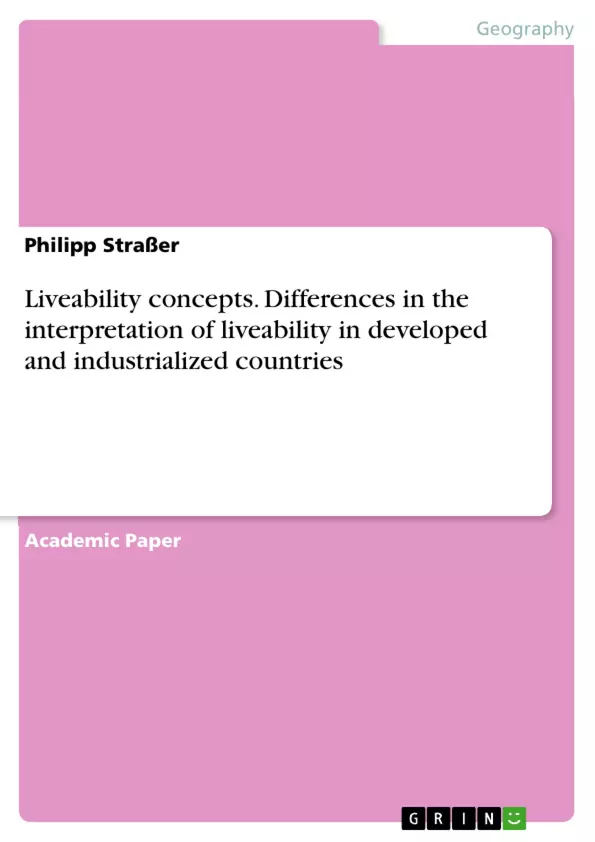This work aims to compare the indicators of the western liveability concept to concepts from developing countries. In this case at least one liveability study from each continent (Latin America, Asia and Africa) that is underrepresented in these classical liveability rankings was chosen.
Liveability is a widely used and popular term nowadays, but it is hard to quantify and compare liveability. The most used and prominent attempts to compare liveability on a worldwide scale are the liveability list. These annual rankings sort big cities according to the score in certain parameters that are weighted and then summed together. Usually cities from the industrialized countries are found at the top of these lists whereas cities of developing countries form the bottom. Maybe there are different concepts of liveability in different parts of the world and these rankings are only the western view on liveability.
Inhaltsverzeichnis (Table of Contents)
- Abstract
- Introduction
- Liveability Rankings
- Criteria of Liveability Rankings
- Liveability Ranking of 2018
- Criticism on Liveability Lists
- Liveability in developing countries
- Bhutan and the Gross National Happiness
- Liveability as a Concept in India
- Liveability- An African Perspective
- Liveability in Latin America on the Example of Nicaragua
- Comparison of Liveability Between Tehran and Tartu
- Conclusion
Zielsetzung und Themenschwerpunkte (Objectives and Key Themes)
This paper aims to compare the indicators of the western liveability concept to concepts from developing countries, investigating whether there are differing interpretations of liveability across different parts of the world.
- The concept of liveability and its various interpretations
- The use of liveability rankings and their limitations
- Liveability in developing countries and alternative conceptualizations
- The importance of considering cultural and contextual factors in assessing liveability
- The need for a more inclusive and comprehensive understanding of liveability
Zusammenfassung der Kapitel (Chapter Summaries)
The paper begins with an introduction to the concept of liveability, highlighting its importance in contemporary discourse and its widespread use in evaluating urban environments. The introduction also explores the difficulties associated with quantifying and comparing liveability, particularly in light of diverse perspectives and interpretations.
The following chapter delves into the use of liveability rankings, examining their methodologies, criteria, and limitations. This includes a discussion of the 2018 liveability rankings and the potential biases associated with these rankings, particularly in their representation of cities from developing countries. The chapter further explores criticisms surrounding liveability lists and their impact on the perception of urban environments.
The subsequent section shifts focus to liveability in developing countries, presenting a comparative analysis of diverse perspectives and conceptualizations. This includes examining case studies from various continents, such as Bhutan, India, Africa, and Latin America, to shed light on alternative approaches to understanding liveability. The chapter explores how different cultural and contextual factors influence the perception and measurement of liveability, suggesting a broader and more inclusive framework for assessing urban environments.
Schlüsselwörter (Keywords)
The key concepts and themes explored in this paper include: liveability, liveability rankings, urban environment, developing countries, cultural diversity, conceptualization of liveability, Gross National Happiness, inclusive urban planning, and comparative analysis.
- Quote paper
- Philipp Straßer (Author), 2019, Liveability concepts. Differences in the interpretation of liveability in developed and industrialized countries, Munich, GRIN Verlag, https://www.grin.com/document/584716



